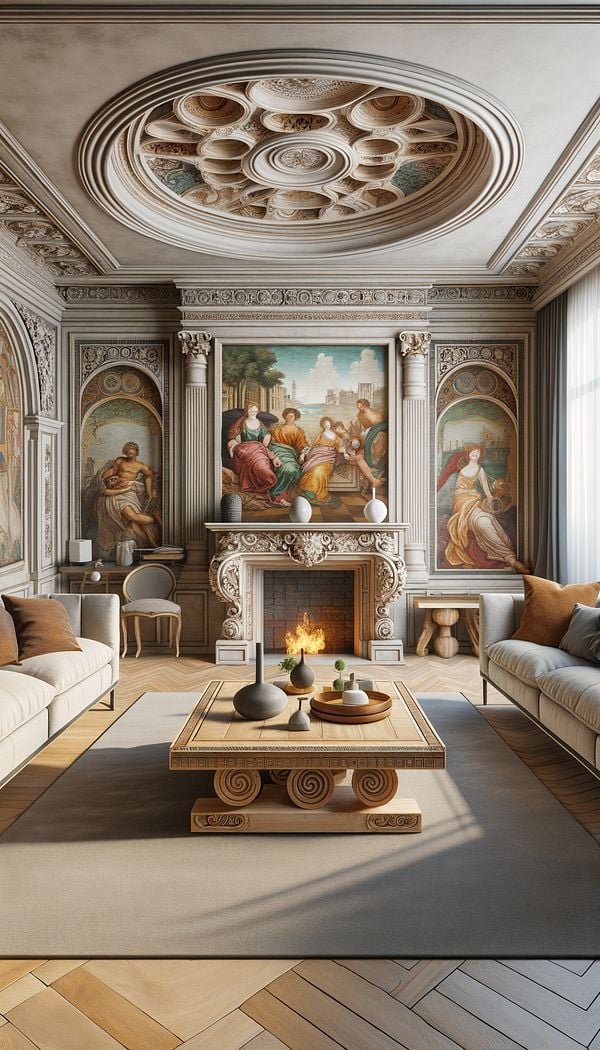What is Renaissance?
The Renaissance is a historical period and artistic movement characterized by a revival of interest in classical art, architecture, and knowledge.
Description
The Renaissance marks a pivotal era in history, spanning from the 14th to the 17th century, that signaled a broad cultural, artistic, and intellectual rebirth following the Middle Ages. This period is distinguished by its emphasis on humanism, a philosophical and ethical stance that prioritizes the value and agency of human beings, individually and collectively. In the context of interior design, the Renaissance contributed to the evolution of architecture, furniture, and decorative arts brought about by the rediscovery and reinterpretation of classical Greek and Roman ideals.
Renaissance interior design is characterized by its harmony, balance, and an overarching sense of order. Architectural elements such as columns, pilasters, and arches are borrowed from classical antiquity, blending seamlessly with the innovative designs of the time. Spaces are meticulously planned, reflecting a high regard for proportion and symmetry. Furniture from this period is often robust and ornately decorated, featuring carvings of acanthus leaves, fruit, and mythological figures, while tapestries, frescoes, and oil paintings serve as major decorative elements, showcasing the period's rich narrative storytelling and advanced technical skills.
Today, Renaissance influences can be seen in neoclassical and classical revival design styles, where elements of this period are invested with new life in modern settings. This enduring legacy reflects the Renaissance's central premise—that the exploration of classical knowledge and styles can lead to new heights of artistic and intellectual achievement.
Usage
In modern interior design, Renaissance elements are often incorporated into spaces that aim to evoke an air of elegance, grandeur, and historical resonance. For instance, a living room might feature a carefully sculpted mantelpiece reminiscent of Renaissance architecture, or a dining room could boast a robust table and high-backed chairs with intricate carvings reflective of the period. Wall treatments might include fresco-like paintings or tapestries, aiming to bring the rich narrative and visual depth characteristic of Renaissance art into contemporary homes.
FAQs
-
How did the Renaissance influence modern interior design?
The Renaissance influenced modern interior design by introducing elements of classical beauty, symmetry, and proportion into spaces. Its emphasis on harmonious design and decorative arts enriched contemporary styles such as neoclassical, inspiring the incorporation of ornate architectural details, balanced layouts, and classical motifs in furniture and decor.
-
What are some key characteristics of Renaissance interior design?
Key characteristics of Renaissance interior design include the use of classical architectural elements like columns and arches, a focus on symmetry and proportion in space planning, richly decorated furniture with carvings and inlays, and the use of tapestries, frescoes, and oil paintings for decoration.
-
Can Renaissance design elements be incorporated into modern homes?
Yes, Renaissance design elements can be seamlessly incorporated into modern homes, often blending with contemporary or other historical styles to create unique, elegant spaces. Elements such as ornate furniture, architectural details reminiscent of the era, and art inspired by Renaissance themes can add historical depth and visual interest to modern interiors.
Practical Application
When incorporating Renaissance elements into contemporary spaces, start with key architectural details or pieces of furniture that embody the era's style. Consider integrating column motifs, archways, or paneled ceilings to echo the architectural grandeur of the period. Selecting furniture with ornate carvings or using wall treatments that mimic frescoes can also evoke the Renaissance aesthetic. Blending these elements with modern design concepts creates a timeless, sophisticated interior that pays homage to both past and present.
-
Architectural Elements199 articles
-
Design Styles478 articles
-
Furniture Types599 articles
-
Decorative Techniques322 articles
-
Art & Sculpture30 articles
-
CoverletA coverlet is a lightweight, decorative bedspread.
-
TrivetA trivet is a stand or support used to hold hot pots, dishes, or serving bowls to protect surfaces from heat damage.
-
Steam BendingSteam bending is a woodworking process where steam is used to soften wood, making it pliable enough to be easily shaped into curves.
-
ChandelierA chandelier is a decorative ceiling-mounted light fixture.
-
RunnerA runner is a long, narrow rug designed to be placed in hallways or staircases.
